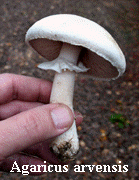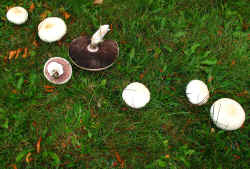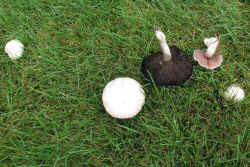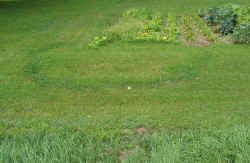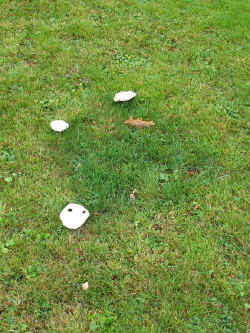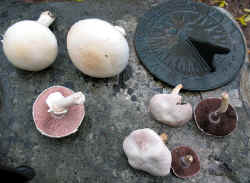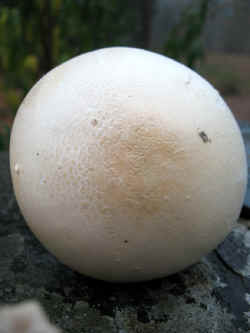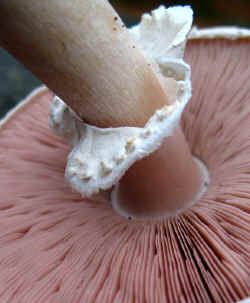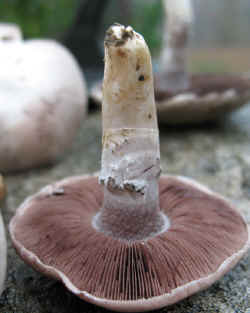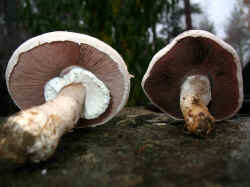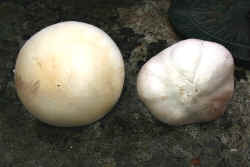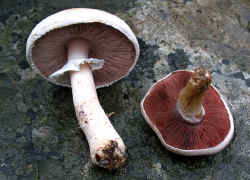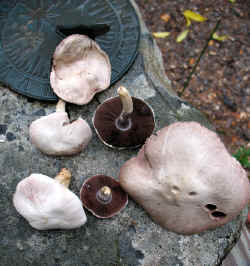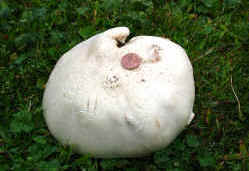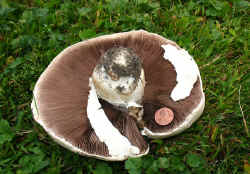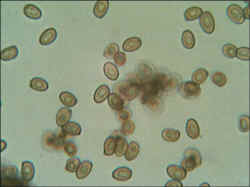|
|
A New England and Eastern Canada Edible and Medicinal Mushroom Resource |
||||||||||||||
|
Agaricus Spp. Starting in late summer and especially near the coast I start looking for the Agaricus species, the horse mushroom (Agaricus arvensis) and the meadow mushroom (Agaricus campestris). These can look a lot like the agaricus mushrooms from your supermarket. The horse mushroom (A. arvensis) is usually quite large. It is often larger than the biggest portobello caps you may buy. This is a species not to be missed! Agaricus campestris, the meadow mushroom usually appears earlier in lawns, pastures and open areas and is similar in size to the white button mushroom but not as thick and dense. Fruit body Horse mushrooms (Agaricus arvensis) are white to slightly tannish or yellowish with long stems that have a hanging veil. The caps have fairly obvious scales and are very regular in shape. The edge of the cap (margin) often has veil remnants making it slightly ragged. Meadow mushrooms have whiter smooth caps of a less regular shape, usually smaller scales, and a shorter often tapering stem. Veil remnants are seen on the stem but only occasionally on the cap margin. Cap (pileus) Horse mushrooms (Agaricus arvensis) 4-12 in. White at first but turning slightly yellowish tan as they mature with a slightly brownish patch at top center and some slight scaliness. As they are about to open the cap can be round and as big as a softball mimicking a Puffball. As the cap starts to open the veil will spread fairly wide and have a circle of pebbly warts finally breaking away leaving a large hanging veil on the stem and a ragged edge at the margin. They have an anise/almond aroma that is quite strong and exceptionally pleasant. It may bruise slightly yellow. Meadow mushroom (Agaricus campestris) cap is 1-5 in. wide, whitish and smooth. The shape can be somewhat wavy and irregular. It may stain slightly pink when handled or waterlogged. Gills (hymenophore/lamellae) Both species have sharp edged, close, free gills (not attached to the stem). In Agaricus arvensis grayish cream in immature unopened specimens. Shortly after the veil breaks pinkish at first, changing to brown and almost black at maturity. If it has white gills, throw it out! Stem (stipe) The horse mushroom (Agaricus arvensis) stem is 3-10 inches tall, 1/2 - 1 inch thick, mostly smooth above the veil, somewhat scaly below the veil, and thicker at the base. There is no cup at the base as with the poisonous amanita. It will usually have a long hanging veil with pebbly warts at the edge that eventually may come off leaving a ring. Dryness will cause the veil to wrinkle and recede or even fall off. It may stain very slightly yellow but the base is not yellow. The meadow mushroom (Agaricus campestris) stem is 1-4 inches tall, whitish to light brown, often tapers to be thinner at the base, usually has just a ring or slight veil remnants and is somewhat scaly above the veil. The stem and flesh may stain slightly pink. There is no cup at the base. Flesh of both species is whitish, fairly thick, and similar in density to the white button mushroom from the store. They both have an almond/anise scent. Horse mushrooms usually smell stronger and don't absorb water easily. Meadow mushrooms can absorb quite a bit of water making them a bit softer and turning the flesh brownish.. Spores Dark Brown When and where to find them (ecology) Horse mushrooms come in September and sometimes continue into November. I hunt coastal areas but often find them other places as well. Lawns and pastures are the best places to look but sometimes they can be around spruce and possibly other conifers especially if there is grass nearby. They seem to like rich soil and probably a manure component. Places in lawns where the grass is quite a bit greener are places they may soon occur. They can be in rings or long lines. I have picked 2 bushels in less than 5 minutes in some places. Remember, these are big! Meadow mushrooms start as early as July and may continue
into November and grow in lawns, pastures and open areas. They can be in
fairy rings where the grass is greener and longer. Inside
a fairy ring is the mycelium that is consuming organic matter in the soil
and pushing outward. Nitrogen is created at the outer part of the ring
causing the grass to become greener and the mycelium to fruit at the edge.
The ring becomes a few inches larger each year. Both species tend to grow in the same places year after year. They are occasionally found very near each other. The last three years we have had strange weather and there have not been many. Preparation These species are just great! They have strong flavor and lend themselves to most cooking processes. I think it best to cook them very shortly after picking so you can capture that strong anise/almond aroma that can dissipate somewhat after short storage. Tempura is a great technique for retaining this anise/almond character. The more mature they get, the stronger the flavor. They are excellent sautéed, as tempura, microwaved, dried, soup, grilled, stuffed, etc. They are great with steak and other strong flavored red meat. You can use these with reckless abandon in many recipes. They are vastly superior in flavor to the Agaricus bisporus harvested from the produce section at your supermarket. The flavor will never be lost in a mix but certainly may overpower. I once found a 14 inch horse mushroom cap! Specimens that fill the entire frying pan are easily possible. I often cook the big caps whole and freeze them with layers of plastic wrap in between so you can take out one at a time during the winter. They do freeze well after cooking and this is often necessary because you often find much more than you can consume right away. A large horse mushroom cap can be used as the "dough" for pizza. I put pizza sauce or salsa on the cap and other meat, vegetables, cheese, etc. One thing to note is that with mature caps a lot of spores will come out and you will have a dark brown juice in your pan. This will darken or discolor foods you add it to quite a bit. That can be a good thing for a gravy but any type of light sauces such as béchamel, alfredo, mornay, etc. will become brown and have far less eye appeal. Meadow mushrooms are smaller and somewhat less versatile due to their size, thickness, and water absorbency. Meadow mushrooms soak up liquid very readily. Horse mushrooms do not absorb water into the flesh easily. I often make slurries by placing mushroom caps in water to soak out the spores for distribution outdoors. Meadow mushrooms readily sponge water up and will eventually sink. Horse mushroom gills will take on water in the gills but still float like a cork even after a couple of days of soaking. Comments These are strong tasting and usable in most situations where you would use button mushrooms from the store. They have heavier, better flavor though. Try only a small bit the first time. Mature specimens make a heavy brown spore print within minutes. They never, ever have white gills when open or a white or green spore print! Agaricus silvicola looks practically identical to Agaricus arvensis but is usually found in conifer woods. It likely to be more slender. It is a choice edible. Agaricus xanthodermis can look similar to these species and is poison. They have a phenolic odor (like creosote), yellowish base, and stain brightly yellow. I have never found it in Maine but there are apparently a few around. Any bad smelling or strongly yellow staining agaricus should be avoided. A horse mushroom may stain very slightly yellow occasionally but not a strong chrome yellow. These species can be used for dyeing wool, some fabrics, or paper and will yield a yellow-tan color with wool when salt water is used as a mordant or a gray green color when cooked in an iron pot. It may be possible to get these species to grow in your lawn by making a slurry from your rejected specimens to extract spores or putting the caps in a place you think would be suitable. I have tried it with all three species. Hoping for success. This year's abnormal weather made assessment of success impossible.
Find more information here: Agaricus
arvensis at MykoWeb
Use of this site will constitute your acceptance of the disclaimer. Copyright 2011 Mushroom-Collecting.com. All rights reserved. |
